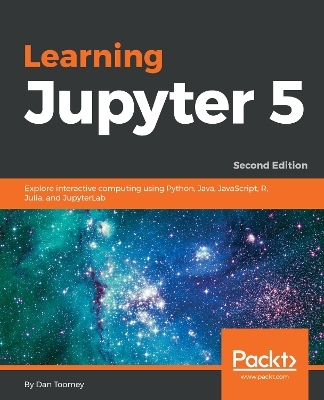
Learning Jupyter 5
Explore interactive computing using Python, Java, JavaScript, R, Julia, and JupyterLab, 2nd Edition
Seiten
2018
|
2nd Revised edition
Packt Publishing Limited (Verlag)
978-1-78913-740-8 (ISBN)
Packt Publishing Limited (Verlag)
978-1-78913-740-8 (ISBN)
In this book, you will learn how to build interactive dashboards in a Jupyter notebook. Explore JupyterHub and various Jupyter widgets through which you can easily perform 3D data visualization, 3D plotting, and geospatial analytics. This book helps you understand BeakerX to create interactive tables and interact with spreadsheets.
Create and share livecode, equations, visualizations, and explanatory text, in both a single document and a web browser with Jupyter
Key Features
Learn how to use Jupyter 5.x features such as cell tagging and attractive table styles
Leverage big data tools and datasets with different Python packages
Explore multiple-user Jupyter Notebook servers
Book DescriptionThe Jupyter Notebook allows you to create and share documents that contain live code, equations, visualizations, and explanatory text. The Jupyter Notebook system is extensively used in domains such as data cleaning and transformation, numerical simulation, statistical modeling, and machine learning. Learning Jupyter 5 will help you get to grips with interactive computing using real-world examples.
The book starts with a detailed overview of the Jupyter Notebook system and its installation in different environments. Next, you will learn to integrate the Jupyter system with different programming languages such as R, Python, Java, JavaScript, and Julia, and explore various versions and packages that are compatible with the Notebook system. Moving ahead, you will master interactive widgets and namespaces and work with Jupyter in a multi-user mode.
By the end of this book, you will have used Jupyter with a big dataset and be able to apply all the functionalities you’ve explored throughout the book. You will also have learned all about the Jupyter Notebook and be able to start performing data transformation, numerical simulation, and data visualization.
What you will learn
Install and run the Jupyter Notebook system on your machine
Implement programming languages such as R, Python, Julia, and JavaScript with the Jupyter Notebook
Use interactive widgets to manipulate and visualize data in real time
Start sharing your Notebook with colleagues
Invite your colleagues to work with you on the same Notebook
Organize your Notebook using Jupyter namespaces
Access big data in Jupyter for dealing with large datasets using Spark
Who this book is forLearning Jupyter 5 is for developers, data scientists, machine learning users, and anyone working on data analysis or data science projects across different teams. Data science professionals will also find this book useful for performing technical and scientific computing collaboratively.
Create and share livecode, equations, visualizations, and explanatory text, in both a single document and a web browser with Jupyter
Key Features
Learn how to use Jupyter 5.x features such as cell tagging and attractive table styles
Leverage big data tools and datasets with different Python packages
Explore multiple-user Jupyter Notebook servers
Book DescriptionThe Jupyter Notebook allows you to create and share documents that contain live code, equations, visualizations, and explanatory text. The Jupyter Notebook system is extensively used in domains such as data cleaning and transformation, numerical simulation, statistical modeling, and machine learning. Learning Jupyter 5 will help you get to grips with interactive computing using real-world examples.
The book starts with a detailed overview of the Jupyter Notebook system and its installation in different environments. Next, you will learn to integrate the Jupyter system with different programming languages such as R, Python, Java, JavaScript, and Julia, and explore various versions and packages that are compatible with the Notebook system. Moving ahead, you will master interactive widgets and namespaces and work with Jupyter in a multi-user mode.
By the end of this book, you will have used Jupyter with a big dataset and be able to apply all the functionalities you’ve explored throughout the book. You will also have learned all about the Jupyter Notebook and be able to start performing data transformation, numerical simulation, and data visualization.
What you will learn
Install and run the Jupyter Notebook system on your machine
Implement programming languages such as R, Python, Julia, and JavaScript with the Jupyter Notebook
Use interactive widgets to manipulate and visualize data in real time
Start sharing your Notebook with colleagues
Invite your colleagues to work with you on the same Notebook
Organize your Notebook using Jupyter namespaces
Access big data in Jupyter for dealing with large datasets using Spark
Who this book is forLearning Jupyter 5 is for developers, data scientists, machine learning users, and anyone working on data analysis or data science projects across different teams. Data science professionals will also find this book useful for performing technical and scientific computing collaboratively.
Dan Toomey has been developing application software for over 20 years. He has worked in a variety of industries and companies, in roles from sole contributor to VP/CTO-level. For the last few years he has been contracting for companies in the eastern Massachusetts area. Dan has been contracting under Dan Toomey Software Corp. Dan has also written R for Data Science, Jupyter for Data Sciences, and the Jupyter Cookbook, all with Packt.
Table of Contents
Introduction to Jupyter
Jupyter Python Scripting
Jupyter R Scripting
Jupyter Julia Scripting
Jupyter Java Coding
Jupyter JavaScript Coding
Jupyter Scala
Jupyter and Big Data
Interactive Widgets
Sharing and Coverting Jupyter Notebook
Multiuser Jupyter Notebook
What’s Next?
| Erscheinungsdatum | 02.09.2018 |
|---|---|
| Verlagsort | Birmingham |
| Sprache | englisch |
| Maße | 75 x 93 mm |
| Themenwelt | Mathematik / Informatik ► Informatik ► Datenbanken |
| Informatik ► Software Entwicklung ► User Interfaces (HCI) | |
| ISBN-10 | 1-78913-740-3 / 1789137403 |
| ISBN-13 | 978-1-78913-740-8 / 9781789137408 |
| Zustand | Neuware |
| Informationen gemäß Produktsicherheitsverordnung (GPSR) | |
| Haben Sie eine Frage zum Produkt? |
Mehr entdecken
aus dem Bereich
aus dem Bereich
Aus- und Weiterbildung nach iSAQB-Standard zum Certified Professional …
Buch | Hardcover (2023)
dpunkt Verlag
CHF 48,85
Mit traditionellen, aktuellen und zukünftigen Erfolgsfaktoren
Buch | Softcover (2018)
Franz Vahlen (Verlag)
CHF 41,70
Wissensverarbeitung - Neuronale Netze
Buch | Hardcover (2023)
Carl Hanser (Verlag)
CHF 48,95


